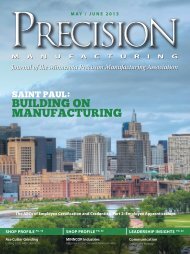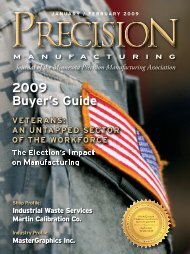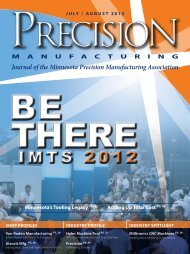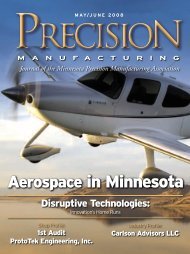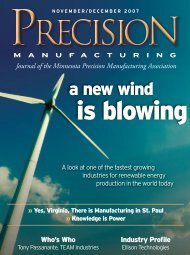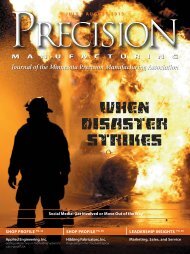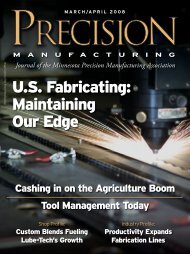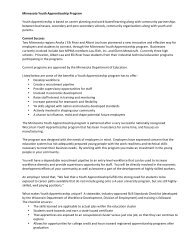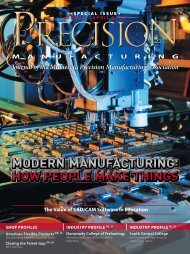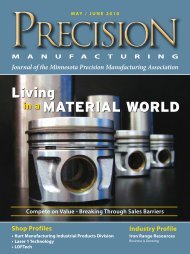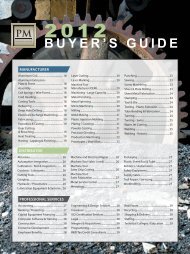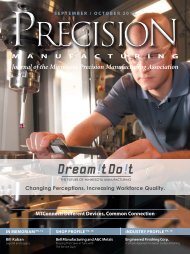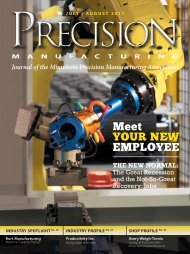Minnesota Exports: - Minnesota Precision Manufacturing Association
Minnesota Exports: - Minnesota Precision Manufacturing Association
Minnesota Exports: - Minnesota Precision Manufacturing Association
You also want an ePaper? Increase the reach of your titles
YUMPU automatically turns print PDFs into web optimized ePapers that Google loves.
Ittruly is with great pleasure that I introduce to you thisLeadership Insights series. A team of us at the MPMAhas been working towards this day since mid-2009, when wefirst voiced the idea for a book on remarkable leadership within<strong>Minnesota</strong>’s manufacturing community. I’d like to recognizeand thank the team: Jaime Nolan and Luann Bartley ofIntrinXec Management, Inc., MPMA’s association managementcompany; B Kyle, vice president of business development at theSaint Paul Port Authority, in Saint Paul, Minn.; Dave Kalina,CEO of Dynamic Group in Ramsey, Minn; Kimberly Arrigoni,controller of Haberman Machine in Oakdale, Minn.; and,posthumously, our dear friend Phil Graber, former president ofNTM, Inc., in Andover, Minn., who passed away in 2011.Let us not forget our most important supporters: oursponsors, members of <strong>Minnesota</strong>’s manufacturing community,all of whom demonstrated their belief in this process throughtheir financial contributions. We honor you and we thank you.~~~~~~~~~~~~~~~~~~The history of manufacturing in this state is rich, thoughthe stories of its leaders have not commanded the attention theydeserve. Our intent with this series is to chronicle the experienceand wisdom of great leaders from our community—the betterto retain this legacy and use it to reach our next generation.Over the next 24 months, each issue of <strong>Precision</strong><strong>Manufacturing</strong> will feature an article about one facet ofleadership, explored through interviews with highly respectedluminaries in that particular topic. We will cover organizationalprinciples, sales/marketing/customer service, recruiting andtraining, acquisitions and diversification, succession, and more.To introduce this series, it is a worthwhile exercise to setthe stage with a review of today's manufacturing milieu. Ourhope is that tomorrow’s leaders will read this, and they may notremember the world as we knew it in 2012.Global SnapshotCompetition is on a global scale. The world is nowcharacterized by widespread technical capability, rapidlyexpanding industrial capacity, aging populations in industrialcountries, worldwide stresses on employment, and burgeoningpublic budget deficits.China is on a path of growth and innovation. The WorldBank expects the United States to grow by just 2 percent in 2012.China alone will grow four times faster than that. By 2017, theInternational Monetary Fund predicts the GDP of China willovertake that of the United States. 1 In October, China’s StateCouncil released a circular on the latest 5-year plan for thedevelopment of strategic emerging industries—essentially abusiness plan to realize innovation goals in industries such asenvironmental protection, biotechnology, high-end equipmentmanufacturing, new energy, and new materials.More companies are near sourcing globally. Ta r i ffengineers increasingly are demonstrating that the costadvantage of manufacturing “off shore” is shrinking—rapidly.In many situations, near shoring is a cost advantage.U.S. students continue to trail behind their peers in higherperforming nations. A 2012 report published by HarvardUniversity’s Program on Education Policy and Governancequoted this recent dire warning issued by a task force sponsoredby the Council on Foreign Relations: “The United States’ failureto educate its students leaves them unprepared to compete andthreatens the country’s ability to thrive in a global economy.”The task force further stated that, “the country will not be ableto keep pace—much less lead—globally unless it moves to fixthe problems it has allowed to fester for too long.” 2 Such viewsare well supported by available evidence.The U.S. population is aging. A common characteristicamong the most developed industrial nations, particularlyJapan and some Western European countries, this shift raisesbona fide concerns about the sustainability of economic growthin those regions. 3 The earliest baby boomers (born between1946-1964) have reached retirement age, currently at the rateof 10,000 a day. Today, approximately one in eight Americans isage 65 or older. According to an August 2012 U.S. News report,“By 2030, one in five people will be considered a senior citizen.And the number of baby boomers age 85 and older will expandto an estimated 21 million by 2050.” 4 That will drop the ratio ofworking age citizens supporting those retirees from 5:1 down to3:1. The potential impact of such change cannot be overstated.This “new normal” economy is growing slowly—but nothiring. <strong>Manufacturing</strong> had a good year in 2012, but businessowners continue to “do more with less.” It has become theirmandate. Investing in automation is much less risky—andless expensive—than investing in people. Couple that with thegrowing skills gap, and we see no end in sight for higher longterm unemployment rates.Deficit spending does not work; balancing trade does.The U.S. government is not alone in continuing to struggle withthis principle. A favorable trade balance can have a very positiveimpact on employment.The national average for a gallon of gas today is $3.39. 5LEADERSHIP INSIGHTS SERIES | INTRODUCTION




